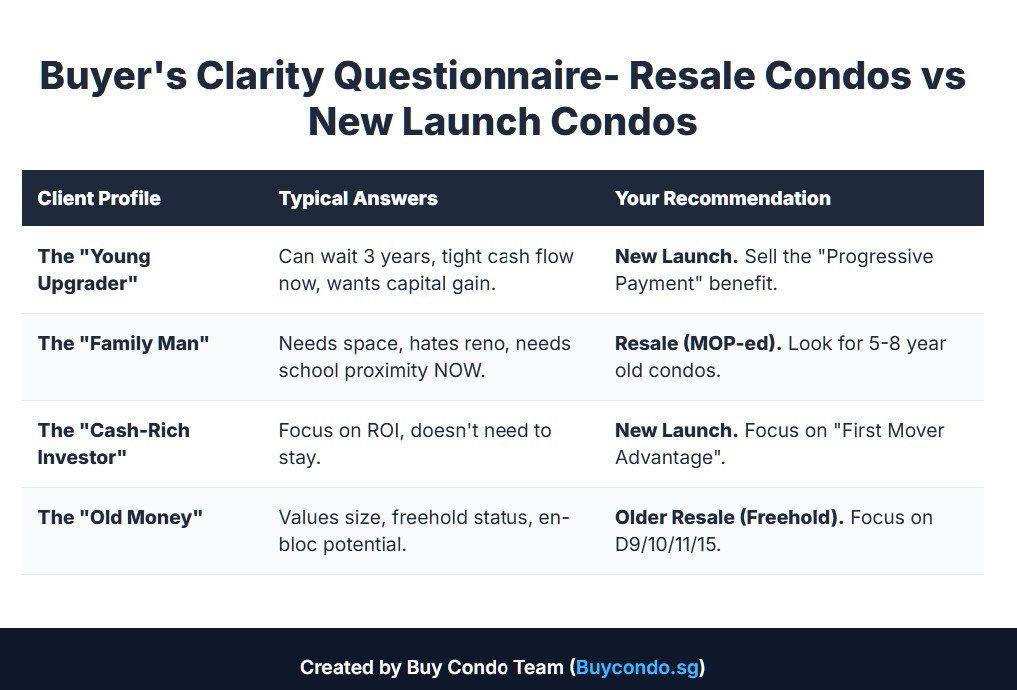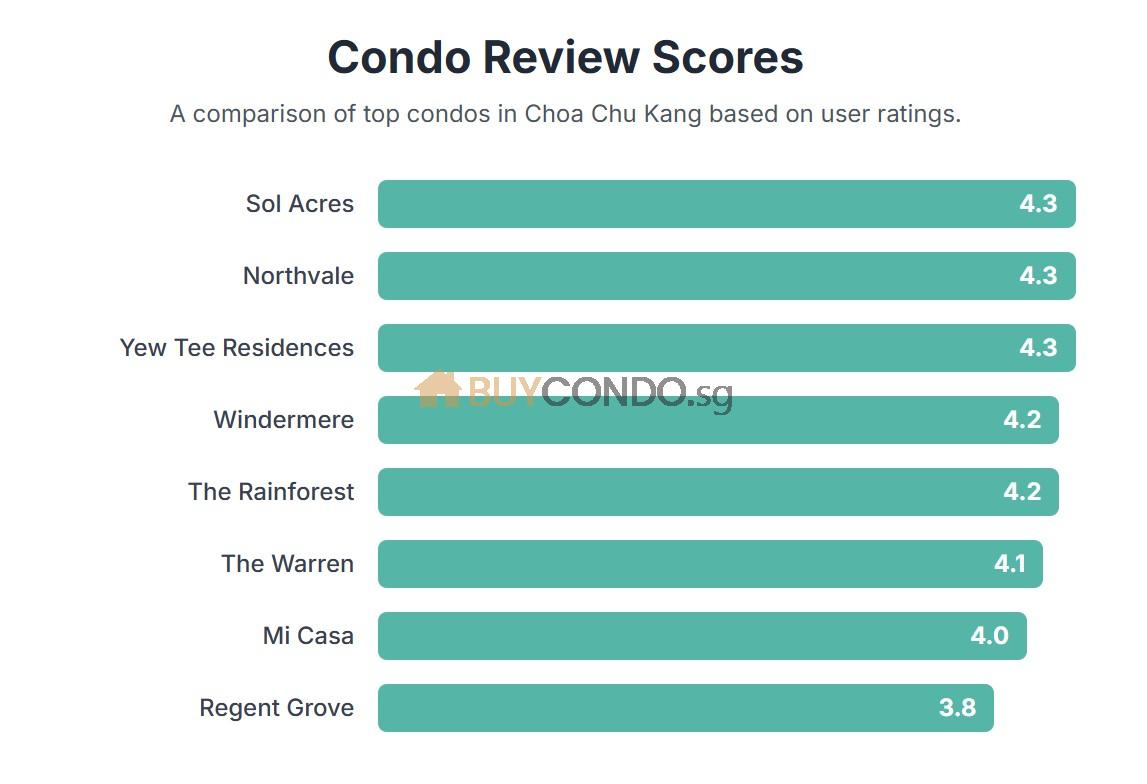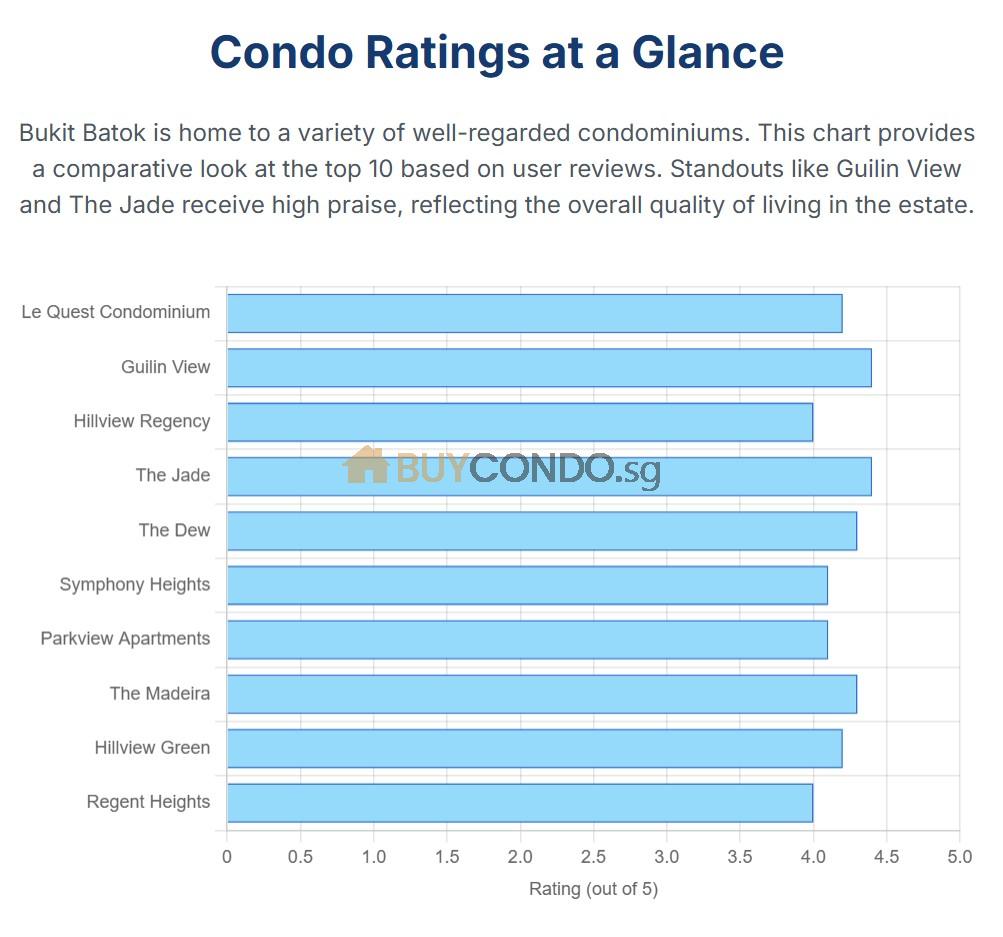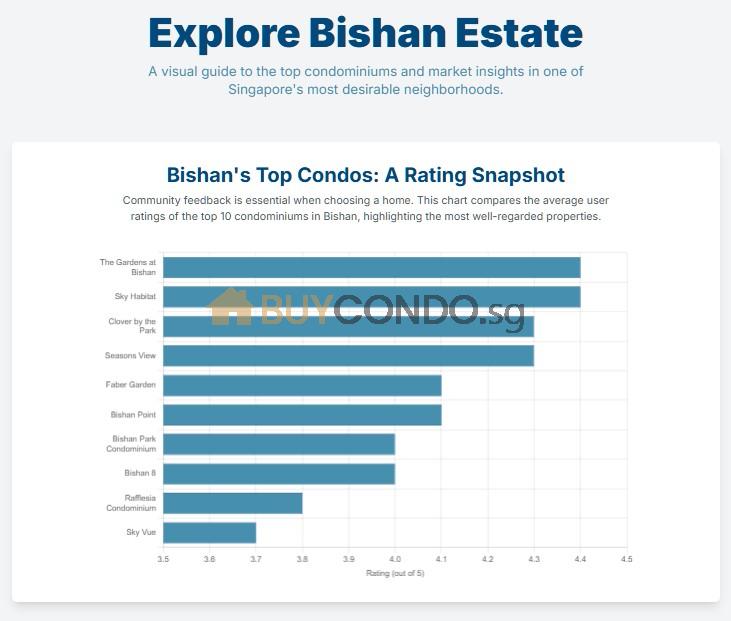Rejuvenation of CCR for Newton and Paterson Developments
(Draft Master Plan 2025)

Executive Summary
The Urban Redevelopment Authority’s (URA) Draft Master Plan 2025 (DMP2025) presents a visionary and multi-faceted strategy for Singapore’s urban evolution over the next 10 to 15 years. Central to this blueprint are the ambitious proposals to introduce approximately 6,000 new private homes in the prime precincts of Newton and Paterson (Orchard). This report provides an exhaustive analysis of these plans, situating them within the broader national strategy, dissecting their potential market and socio-spatial impacts, and offering strategic recommendations for key stakeholders.
The analysis reveals that the Newton and Paterson developments are not merely housing projects but are central pillars in a deliberate strategy to rejuvenate and future-proof Singapore’s city center. The Newton plan aims to transform a transient transport node into a vibrant, green “urban village” through meticulous placemaking, heritage integration, and community-centric design. In contrast, the Paterson proposal envisions a landmark, high-intensity “vertical village” above Orchard MRT station, designed to re-anchor Orchard Road’s global prestige and create a new icon of ultra-luxury urban living.
These developments are poised to have a profound impact on the Core Central Region (CCR) property market. They will establish new pricing benchmarks, increase the competitive pressure on older developments, and likely act as a catalyst for a renewed collective sale cycle. However, the report identifies a critical policy tension: the ambitious vision for a residential-led city center revival is confronted by the significant headwind of prevailing property cooling measures, most notably the 60% Additional Buyer’s Stamp Duty (ABSD) for foreign purchasers. The market’s ability to absorb this new premium supply is heavily contingent on global economic conditions and the future trajectory of this macro-prudential policy.
The report concludes with strategic recommendations. Investors should differentiate between Newton’s long-term, character-driven value uplift and Paterson’s high-risk, trophy-asset profile. Developers must factor the complexities of heritage integration into their financial models for Newton and propose architecturally iconic, transformative concepts for the Paterson “white site.” For policymakers, a phased and flexible supply rollout, a long-term strategic review of the ABSD framework, and robust public communication will be crucial to navigate the delicate balance between achieving visionary urban goals and maintaining market stability and social inclusivity.
Draft 2025 Master Plan Newton and Paterson
Section 1: The DMP2025 Strategic Imperative: Rejuvenating Singapore’s Core
The proposals for Newton and Paterson within the Draft Master Plan 2025 are not isolated initiatives. They represent calculated keystones in a comprehensive national strategy aimed at reinforcing the dynamism, livability, and long-term resilience of Singapore’s urban core. To fully appreciate their significance, one must first understand the foundational principles of the Master Plan itself and the strategic imperatives driving this new phase of central region intensification.
1.1 The URA Master Plan as a Visionary Blueprint
The URA Master Plan is the statutory land use plan that guides Singapore’s physical development over a 10 to 15-year medium-term horizon.1 Reviewed every five years, it serves as a crucial strategic document for coordinating land use, infrastructure, and transportation development across the island.4 In a nation defined by land scarcity, the Master Plan is the primary instrument for optimizing limited resources, balancing the competing demands of economic growth, environmental sustainability, and quality of life for residents.6
The DMP2025 marks a notable evolution in this planning process. Built upon the foundations of the Long-Term Plan Review, its final form is the culmination of what National Development Minister Chee Hong Tat described as Singapore’s most extensive public engagement effort to date, incorporating feedback from nearly 220,000 participants since October 2023.6 This deep consultative process signals a deliberate shift towards a more human-centric and co-created urban future, where the aspirations of citizens are woven into the fabric of the city’s blueprint.13 This philosophical shift moves beyond a singular focus on infrastructural “hardware” and economic efficiency to embrace the “software” of urban life: wellness, community cohesion, cultural identity, and overall quality of life. This implies that the success of future developments, particularly in the prime CCR, will be judged not only by their location and luxury but by the holistic lifestyle, sense of community, and unique character they offer.
1.2 Core Strategic Pillars of DMP2025
The DMP2025 is structured around several key strategic pillars that collectively define its vision for Singapore.
- “Shaping a Happy, Healthy City”: This is a central theme that permeates the plan, emphasizing the creation of inclusive neighborhoods that support wellness and foster strong community ties.10 A key objective is to provide a more diverse array of housing options to cater to different needs, budgets, and life stages.15 This includes not only new private homes in central locations but also senior-friendly Community Care Apartments (CCAs), private assisted living facilities, and new public housing in a variety of settings.10
- Enabling Sustainable Growth: This pillar embodies a sophisticated dual strategy. On one hand, it continues the push for decentralization, developing vibrant sub-regional commercial centers in areas like Bishan and Woodlands to bring jobs closer to homes and ease pressure on the central transport network.6 On the other hand, it simultaneously pursues the strategic revitalization and intensification of the traditional city center.4 This dual approach is not contradictory but symbiotic. By successfully creating robust regional hubs, the plan creates the necessary “breathing room” to re-imagine and redevelop the core, shifting its focus from being purely a place of work to a high-quality environment for living and recreation.
- Strengthening Urban Resilience & Stewarding Heritage: The plan demonstrates a forward-looking approach to future-proofing the nation while preserving its soul. It addresses long-term challenges like climate change through ambitious projects like the proposed Long Island off the East Coast.7 Concurrently, it places a strong emphasis on stewarding Singapore’s heritage. This is achieved through the conservation and adaptive reuse of significant buildings, such as the former Pasir Panjang English School, and the designation of “identity nodes”—areas with distinctive character that are protected and enhanced through specific design guidelines.4
1.3 Why Newton and Paterson? The Rationale for Central Region Intensification
The decision to introduce a significant number of new homes in Newton and Paterson is a direct manifestation of these strategic pillars. It reflects what officials have termed a “conscious effort for citizens to belong to the city, feel a sense of belonging, and have fair access to all parts of our island”.4 By injecting a substantial residential population back into the heart of Singapore, the plan aims to transform the Central Business District (CBD) and its surrounding areas from a 9-to-5 commercial zone into a vibrant, mixed-use district that is active 24/7.7
This strategy serves multiple purposes. It increases the vibrancy and economic resilience of the city core, counteracting the “hollowing-out” effect observed in many global cities, particularly in the post-pandemic era of hybrid work. Furthermore, these high-profile central developments act as a strategic counterbalance to other major long-term projects on the horizon, such as the Greater Southern Waterfront.2 This ensures that the traditional Orchard and Newton core maintains its primacy and continues to evolve, preventing stagnation and reinforcing its status as a premier global destination.
Section 2: The Newton Transformation: Crafting a Green Urban Village
The DMP2025 proposal for Newton is far more than a simple land-use rezoning; it is a meticulously crafted plan for urban placemaking. The vision is to fundamentally transform what is currently a high-traffic, transient interchange into a cohesive and desirable residential enclave, defined by greenery, heritage, and a strong sense of community.
2.1 The Development Blueprint: 5,000 Homes and a New Heart
The plan outlines the progressive development of approximately 5,000 new private residences across three distinct but interconnected clusters: Newton Circus, Scotts Road, and Monk’s Hill.16 This significant injection of housing supply will be anchored by a new central focal point: a “Village Square.” This is envisioned as a high-density, mixed-use development situated strategically next to the Newton MRT interchange and the iconic Newton Food Centre, creating a vibrant hub for residents and visitors alike.4
Crucially, the URA has stipulated that future developments will be “introduced sensitively” and guided by urban design guidelines intended to “complement the area’s existing character”.16 This signals a deliberate move away from monolithic, tabula rasa development towards a more nuanced approach that respects and builds upon the existing urban fabric.
2.2 Placemaking through Heritage and Greenery
The Newton plan is a textbook example of leveraging green and heritage assets to create a distinct sense of place. This strategy is most evident in the plan’s treatment of Monk’s Hill Road. This road, which is home to distinctive apartment blocks that once served as municipal workers’ quarters during the colonial era, will be transformed into a linear park.6 This intervention will not only preserve the mature trees and heritage buildings that line the road but will also create a vital green spine for the new neighborhood.4
This new park is not merely an aesthetic feature; it is a key piece of connective infrastructure. It will form a green corridor that provides a direct, pedestrian-friendly link from the Newton MRT station to the historic Emerald Hill conservation area.21 This vastly improves the walkability and connectivity of the precinct, stitching the new developments seamlessly into the surrounding heritage landscape.
This deliberate strategy has been formalized through the URA’s designation of Newton as one of three new “identity nodes” in Singapore.19 This designation is more than just a label; it is a powerful development control tool that underscores the URA’s commitment to the area’s rejuvenation. It ensures that the vision of a community-centric neighborhood, with greenery, heritage, and identity woven into its core, is not just a marketing slogan but is embedded into the physical form of the new buildings through enforceable design guidelines. This approach de-risks the development from a community and aesthetic perspective, ensuring that the new housing supply enhances, rather than detracts from, the area’s unique character, thereby protecting and augmenting long-term property values.
2.3 Market Impact and Value Proposition
The Newton proposal has been met with considerable optimism from property market analysts, with some hailing it as arguably the “star of the entire Draft Plan”.23 The enthusiasm stems from the rare opportunity to witness and participate in such a large-scale, character-defining redevelopment within a mature CCR neighborhood.
The strategic introduction of ground-level retail, integrated public spaces, and significantly improved walkability is expected to fundamentally reposition Newton. It will evolve from being primarily a gateway for CBD commuters and an address for investors into a “true residential enclave” that is attractive in its own right.23 This transformation is likely to broaden its appeal significantly, attracting a wider demographic of homebuyers, including affluent families and owner-occupiers who value community and lifestyle amenities alongside centrality.23 This shift is anticipated to create a substantial value uplift, benefiting not only the new projects but also existing properties in the vicinity that will ride the wave of the precinct’s rejuvenation. The plan is, in essence, a form of urban surgery, designed to remedy Newton’s long-standing character deficit as a place people primarily pass
through rather than go to. By creating a “heart” for the precinct, the URA is unlocking a new tier of real estate value.
Section 3: The Paterson Apex: A Vertical Hub on Orchard Road
If the Newton plan is about crafting a neighborhood, the Paterson proposal is about creating a landmark. It is a statement of ultra-luxury, high-intensity urbanism designed to serve as a new apex for the Orchard Road precinct and a powerful catalyst in its ongoing evolution into a multifaceted lifestyle destination.
3.1 The Development Blueprint: A Landmark Integrated Hub
The plan calls for the development of approximately 1,000 new private homes in the Paterson area, which lies on the doorstep of Orchard Road.4 The undisputed centerpiece of this proposal is a landmark mixed-use integrated development to be constructed directly above the Orchard MRT Interchange, which serves both the North-South Line (NSL) and the Thomson-East Coast Line (TEL).4
This project, located on the highly strategic site of the former Institute of Education and later Raffles Junior College, is envisioned as a “vertical village”.22 It will integrate high-end private residences with retail, food and beverage (F&B), and office spaces within a single, iconic structure.16 This vertical integration aims to create a self-sustaining ecosystem of living, working, and leisure, maximizing the potential of one of Singapore’s most valuable land parcels.
3.2 The Power of Zoning: “White Site” and Plot Ratio Intensification
To realize this ambitious vision, the URA is deploying its most powerful planning tools. The land parcel situated above the Orchard MRT station will be rezoned from its previous designation of ‘residential with commercial at 1st storey’ to a “white site”.24 This is a critical move. A white site zoning provides developers with maximum flexibility, encouraging them to submit innovative and transformative proposals that integrate a variety of uses in a synergistic way.1 It effectively launches an informal global competition for developers and architects to propose a truly world-class, architecturally significant building that will redefine the Orchard skyline.
This is coupled with a significant intensification of land use. The Gross Plot Ratio (GPR) for this site is proposed to be increased to a very high 5.6.24 The GPR is a measure of the maximum permissible development intensity, and a figure of this magnitude signals the government’s clear intent for a landmark, high-density development that fully capitalizes on its prime, transit-oriented location. The resulting structure will not just be a building but a new icon, serving as a powerful marketing tool for the rejuvenated Orchard Road and for Singapore on the global stage.
3.3 Redefining “The Lifestyle Destination”
The Paterson development is a core component of the broader, long-term strategy to rejuvenate Orchard Road. The goal is to evolve the famous shopping belt beyond its traditional retail focus into a comprehensive “live-work-play” destination.2 The introduction of a significant and affluent residential population directly onto Orchard Road is a key part of this strategy. It aims to generate consistent, round-the-clock footfall and create a more vibrant, lived-in atmosphere. This is crucial for the long-term health of the precinct, especially as traditional brick-and-mortar retail continues to face structural challenges from the growth of e-commerce.23
The success of this landmark project, however, is intrinsically linked to Singapore’s broader economic policies, particularly the ABSD regime. A development of this scale and ultra-luxury positioning, with an estimated 1,000 premium units, cannot be sustained by the domestic market alone. Its commercial viability will depend heavily on robust demand from foreign high-net-worth individuals and global investors. The current 60% ABSD rate for foreigners acts as a powerful deterrent to this demand segment, a fact reflected in the cooling of the luxury property market since its implementation.16 This creates a direct policy tension. While the long 10 to 15-year timeline of the Master Plan provides policymakers with flexibility, the ultimate success of this strategic URA project may necessitate a future recalibration of the ABSD policy, perhaps through targeted relief for high-value strategic developments or a broader review once short-term market stability is assured.
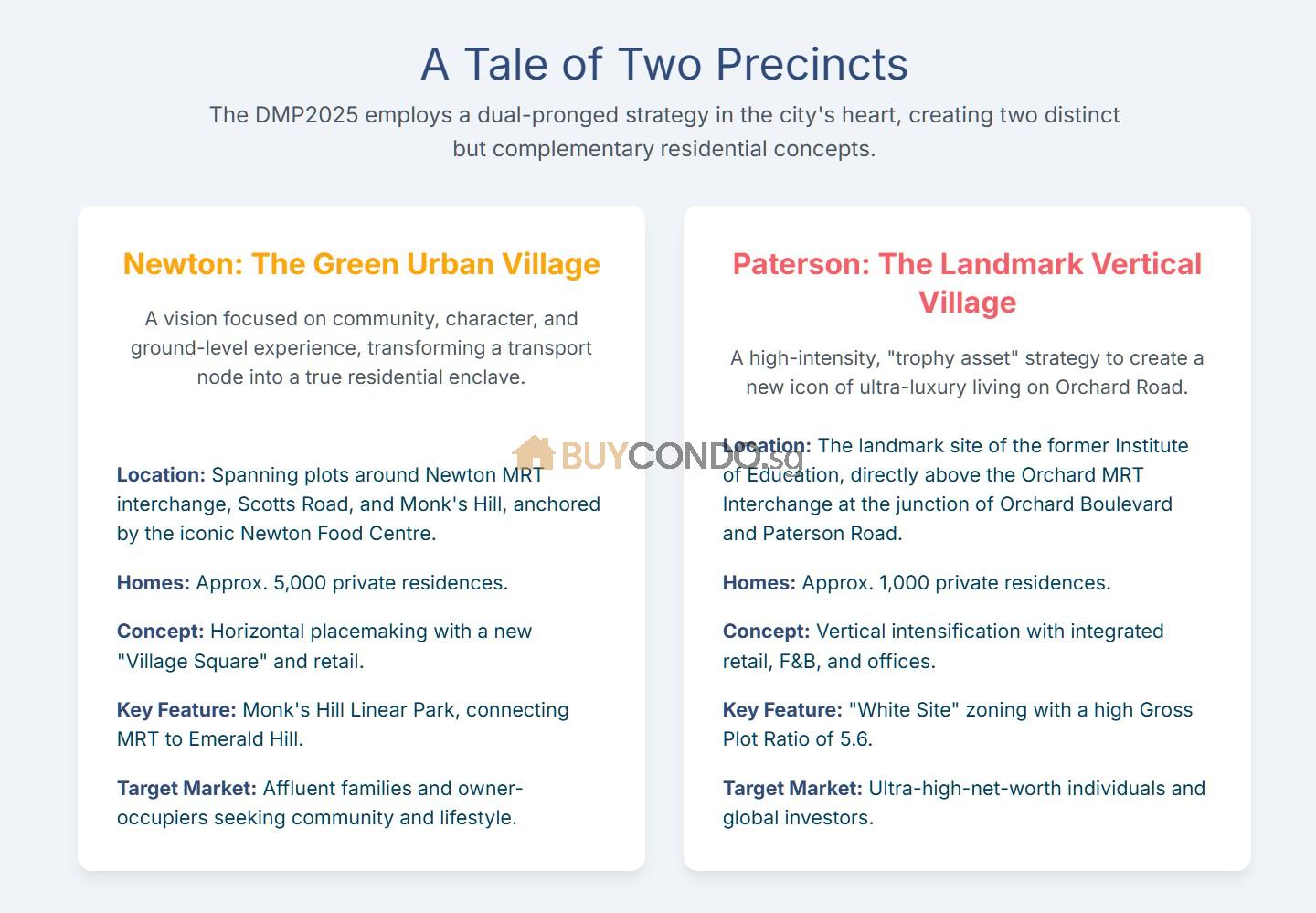
Section 4: A Tale of Two Precincts: Comparative Analysis and Regional Impact
The DMP2025 proposals for Newton and Paterson, while geographically proximate and both focused on the CCR, represent two distinct and sophisticated strategies for urban rejuvenation. Analyzing them in tandem reveals a nuanced “portfolio approach” to development that aims to diversify the CCR’s residential offerings and catalyze a broader regional transformation.
4.1 Synergies and Divergences
The two projects are designed to be complementary rather than competitive, each targeting a different segment of the high-end property market.
- Newton’s Horizontal Placemaking: The Newton plan focuses on creating value through horizontal placemaking. Its key features—the linear park, the village square, the integration with Emerald Hill—are about crafting a ground-level experience and fostering a sense of community. It is a “value-add” strategy, taking an under-utilized area and fundamentally transforming its character to unlock a new tier of residential desirability. Its target demographic is likely to be affluent families and owner-occupiers who seek a greener, community-oriented lifestyle without sacrificing central connectivity.
- Paterson’s Vertical Intensification: The Paterson plan, in contrast, is a “trophy asset” strategy focused on vertical intensification. Its value proposition is derived from its iconic status, its direct integration with a major transport hub and premier retail, and the sheer prestige of its Orchard Road address. It is designed to be a landmark of global standing. Its target market is the ultra-high-net-worth individual, the global investor, and those seeking a statement home as a generational asset.
This portfolio approach allows the URA to cater to a wider spectrum of the high-end market, enhancing the overall depth and appeal of the CCR’s residential landscape.
Table 1: Comparative Overview of Newton and Paterson Proposals
| Feature | Newton Proposal | Paterson Proposal |
| Housing Quantum | Approx. 5,000 private homes | Approx. 1,000 private homes |
| Key Concept | Green “Urban Village” | Landmark “Vertical Village” |
| Primary Housing Type | Private residences | Private residences, likely with branded/serviced options |
| Key Amenities | “Village Square,” Newton Food Centre, retail | Integrated retail, F&B, offices |
| Green Space Strategy | Monk’s Hill Linear Park, green corridors | Vertical greenery, potential sky terraces |
| Heritage Integration | Central to the plan; adaptive reuse of colonial-era buildings | Minimal; focus on creating a new landmark |
| Zoning Highlight | Designated as a new “Identity Node” | Rezoned to a flexible “White Site” |
| Target Market | Affluent owner-occupiers, families | Ultra-high-net-worth individuals, global investors |
| Investment Profile | Long-term capital appreciation via character transformation | High-risk, high-reward trophy asset |
Sources: 4
4.2 The CCR Ripple Effect: Supply, Pricing, and En-Bloc Potential
The combined injection of 6,000 new, high-quality private homes into the CCR over the next decade and a half will inevitably create significant ripple effects across the regional property market.16
Firstly, these new developments will establish new pricing benchmarks for the CCR. Their modern specifications, integrated amenities, and prime locations will command a premium, likely widening the price gap between new-build properties and the ageing housing stock in Districts 9, 10, and 11. This will exert competitive pressure on older condominiums, which may struggle to attract buyers and tenants without significant refurbishment.
Secondly, this dynamic is expected to act as a powerful catalyst for the collective sale (en-bloc) market. As the URA’s plans demonstrate the potential for significant land value uplift through redevelopment and intensification, owners of older, under-utilized properties will be increasingly motivated to pursue a collective sale.16 The new benchmarks set by the Newton and Paterson projects will provide clear financial incentives for such moves, potentially triggering a new wave of en-bloc activity in the CCR.
Finally, the rejuvenation of the core could have a “cascade effect” on the wider property market. While the high price points of the new CCR units will remain inaccessible to the majority, the enhanced vibrancy and amenities of the core will increase its overall desirability. This may lead to aspiring CCR residents who are priced out turning to the next best alternative in the Rest of Central Region (RCR), driving up demand and property values there. Simultaneously, the decentralization strategy that underpins the Master Plan, which aims to create more employment in regional hubs, will directly support housing and rental demand in the Outside Central Region (OCR), contributing to a more balanced and resilient island-wide property market.15
Section 5: Navigating the Headwinds: Risks, Challenges, and Strategic Considerations
While the DMP2025 proposals for Newton and Paterson are ambitious and visionary, their implementation is not without significant challenges and risks. A balanced assessment requires acknowledging the practical, economic, and social headwinds that must be navigated for these plans to come to fruition.
5.1 Execution and Infrastructure Strain
The physical execution of these large-scale projects presents a formidable logistical challenge. Carrying out multi-year construction in two of Singapore’s most densely populated and heavily trafficked areas will require meticulous planning to mitigate disruption.23 Issues such as traffic management, noise and dust pollution, and construction logistics will need to be expertly handled to minimize the impact on the thousands of residents and businesses in the surrounding areas.
Beyond the construction phase, the influx of a new residential population—potentially over 15,000 people, given an average household size of 2.5 for the 6,000 units—will place additional strain on existing infrastructure. Concurrent upgrades to utilities, public transport capacity, local road networks, and community services will be essential to support this growth and maintain the high quality of life that is a hallmark of these prime districts.
5.2 Market Absorption and Economic Realities
The most significant economic risk is the market’s capacity to absorb 6,000 new premium-priced residential units over the plan’s 10 to 15-year horizon. This risk is amplified by the backdrop of increasing global economic uncertainty, geopolitical shifts, and evolving housing demand.6
The primary headwind remains the government’s property cooling measures, specifically the 60% ABSD levied on foreign buyers.16 This measure has already had a chilling effect on the luxury property market, which has historically relied on foreign demand.26 As analyzed previously, the commercial viability of the Paterson project, in particular, is heavily dependent on this demand segment. The successful absorption of this new supply pipeline at projected price points will be a major test for the CCR market and may hinge on the government’s willingness to review and potentially adjust the ABSD framework in the medium to long term.
Table 2: Analysis of Key Land Parcels and Zoning Changes : Rejuvenation of CCR for Newton and Paterson Developments
| Location/Site | Previous Master Plan Zoning | DMP2025 Proposed Zoning | Previous GPR | DMP2025 Proposed GPR | Key Implications |
| Site above Orchard MRT | Residential with Commercial at 1st Storey | White Site | – | 5.6 | Maximum flexibility for a landmark integrated development; signals high-density, high-value intent. |
| Plots off Winstedt Road (Monk’s Hill) | Reserve Site | Residential | – | 3.5 | Unlocks previously reserved land for new housing, contributing to the Newton “urban village” concept. |
| Former UOB Kay Hian / Kheng Leong Bldgs | Reserve Site | White Site | up to 4.9 | – | Rezoned for the new “Village Square” mixed-use development, the heart of the Newton plan. |
Source: 24
5.3 The Social Contract: Exclusivity vs. Inclusivity
The decision to dedicate large, prime parcels of state-owned land to exclusively private, high-cost housing inevitably raises social and political questions. Public and online discourse reflects a degree of apprehension about exacerbating social stratification and gentrification in the heart of the city.28 While the broader DMP2025 includes provisions for new public housing in other well-located areas like Dover, Keppel, and Mount Pleasant, the concentration of luxury in the most central precincts touches upon the sensitive issue of inclusivity.4
The biggest non-financial risk to these projects, therefore, is public perception and the maintenance of the social contract. The government’s narrative, which strongly emphasizes the extensive public consultation process and the benefits that accrue to all Singaporeans—such as enhanced public spaces, improved connectivity, and a more vibrant city—can be seen as a pre-emptive strategy to manage this risk. The long-term success of these developments depends not only on market forces but also on the government’s ability to maintain a broad social consensus that these projects, while exclusive in their residential offerings, serve the wider national interest through economic dynamism, tax revenue generation, and the enhancement of Singapore’s global city status.
Furthermore, the plan’s admirable emphasis on heritage preservation in Newton introduces a hidden complexity. While integrating heritage buildings is a clear positive for placemaking and cultural value, it imposes significant constraints and costs on developers. The process of conserving and adaptively reusing older structures is technically complex, potentially leading to longer project timelines and higher construction costs. Bids for Government Land Sale (GLS) sites in these designated areas will need to meticulously factor in these “heritage costs,” which could influence land prices and final unit pricing. This represents a tangible trade-off between creating cultural value and maximizing pure economic efficiency.
Section 6: Conclusion and Strategic Recommendations
The Draft Master Plan 2025 proposals for Newton and Paterson represent a bold, forward-looking vision for the heart of Singapore. They are set to fundamentally redefine their respective precincts, catalyze the rejuvenation of the wider Core Central Region, and establish new benchmarks for luxury urban living. The plan skillfully weaves together goals of economic vibrancy, heritage stewardship, and enhanced livability. However, its ambitious vision is confronted by the pragmatic realities of market absorption and the constraints of macro-prudential policies. The long-term success of this urban transformation hinges on the delicate navigation of this central tension.
6.1 Synthesis: The Future Trajectory of Singapore’s Urban Core
The Newton and Paterson developments are more than just additions to the housing stock; they are strategic interventions designed to shape the future trajectory of Singapore’s urban core. Newton’s transformation into a green “urban village” will create a new model for community-centric living in a prime district. Paterson’s landmark “vertical village” will re-anchor Orchard Road’s prestige on a global scale. Together, they represent a sophisticated portfolio approach to urban renewal, diversifying the CCR’s appeal and reinforcing its economic and social vitality for decades to come. The critical challenge lies in aligning this long-term vision with short- and medium-term market conditions and policy frameworks.
6.2 Strategic Recommendations
Based on the comprehensive analysis, the following strategic recommendations are proposed for key stakeholders:
For Investors:
- Newton Precinct: The investment thesis for Newton should be based on long-term capital appreciation driven by the fundamental transformation of the precinct’s character. The value unlock will be gradual as the “urban village” concept takes shape. Investors should identify opportunities in well-located, older properties in the vicinity that are poised to benefit from the significant positive externalities and value uplift generated by the new developments and amenities.
- Paterson Precinct: The Paterson development is a high-risk, high-reward proposition for a trophy asset. Entry prices will be at an absolute premium, and investment success is heavily contingent on future foreign demand and potential shifts in the ABSD policy. This should be viewed as a generational asset for wealth preservation rather than a vehicle for short-term trading.
For Developers:
- Bidding for Newton GLS Sites: Financial models for land bids in the Newton area must meticulously incorporate the additional costs, extended timelines, and technical complexities associated with heritage building conservation and integration. The winning proposals will be those that can demonstrate a genuine ability to deliver on the URA’s “urban village” vision, not just maximize unit count.
- Proposing for the Paterson White Site: Securing the Paterson White site will require a visionary, architecturally iconic proposal that transcends standard luxury. Developers should focus on creating a truly integrated, world-class landmark that justifies a new price echelon for Singapore real estate and contributes significantly to the public realm of Orchard Road.







